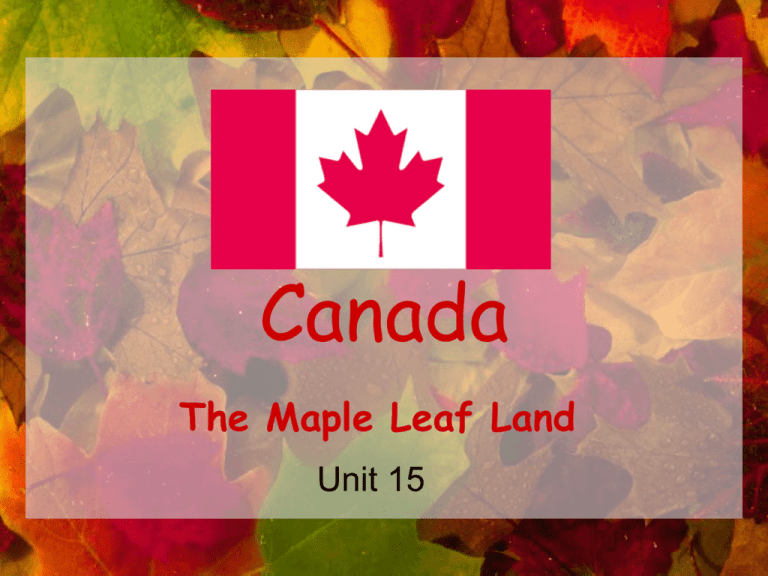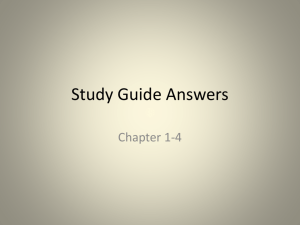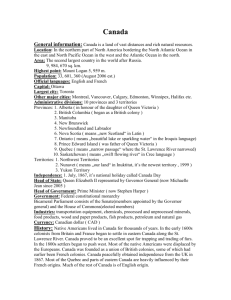Intro to Canada
advertisement

Canada The Maple Leaf Land Unit 15 Maple Leaf Land • • • • • • A Bird’s-Eye View of Canada The Country and its People Canadian Government and Politics The Canadian Mosaic The Canadian Economy Canada’s International Relations A Bird’s-Eye View of Canada • General Information • Scenic Canada • Geography General Information The National Flag of Canada, also known as the Maple Leaf, and l'Unifolié (French for "the one-leafed"), is a red flag with a white square in its centre, featuring a stylized 11-pointed red maple leaf. The flag is the symbol of the nation's unity, for it, beyond any doubt, represents all the citizens of Canada without distinction of race, language, belief or opinion. National Anthem: O Canada Scenic Canada Niagara Falls Horseshoe Falls Canadian Rockies The Mackenzie River The Mackenzie River is the longest river in Canada covering a distance of around 1800 km Great Slave Lake Montreal Toronto Vancouver Ottawa The Country and its People Unit 1 Geography • Location: Northern North America, bordering the North Atlantic Ocean and North Pacific Ocean, north of the conterminous US • Area: total: 9,976,140 sq km Area--comparative: slightly larger than the US • Climate: varies from temperate in south to subarctic and arctic in north • Terrain: mostly plains with mountains in west and lowlands in southeast Geography Stretching from the Pacific to the Atlantic and deep into the Arctic, Canada is a big country, with a lot of places to experience. Rugged mountain peaks and soft sandy beaches. Bustling cosmopolitan cities surrounded by quiet cozy villages. Historic sites brimming with authentic traditions and stories from the past. Galleries showcasing modern works and masters of Canadiana. Innovative attractions to delight the imagination. Diverse and endlessly engaging. Canada is made for exploring. Canadian Identities Internet Jokes on Cultural Differences 英国移民 • Aussies: dislike being mistaken for Pommies (Brits) when abroad. • Canadians: are rather indignant about being mistaken for Americans when abroad. • Americans: encourage being mistaken for Canadians when abroad. • Brits: can't possibly be mistaken for anyone else when abroad. Internet Jokes on Cultural Differences • Americans: spell words differently, but still call it "English". • Brits: pronounce their words differently, but still call it "English". • Canadians: spell like the Brits, pronounce like Americans. • Aussies: add "G'day", "mate" and a heavy accent to everything they say. G'day • G'day,mate..how are you, to-die? (pronounced "Good-die, mate..how are you, to die?) which means "Good-day, my friend...how are you doing today ?" (in BBC English) is how you'll often be greeted in Australia.... and it's not someone rudely asking how you are going to pass away. Canadian Identity • Compared with the States, it merged quite late, slowly and peacefully in the 20th century. • Defined in contrast with the Americans -White North (but not the West), Irony (but not Innocence), victim mentality (but not heroism), Mounties but not cowboy, etc. • Characteristics (?): Gentleness + violent hockey, Two solitudes. 加拿大骑警 The Regions of Canada • Provinces and territories are normally grouped into the following regions (generally from west to east): • The North • The West • The Prairies • Central Canada • The Atlantic Region 夜半太阳之地 • • • • The North The land of midnight sun 第一民族,烟劳人,美地人 Aboriginals: First Nations, Inuit, Metis. Three administrative territories Economy The West Coast 西岸 • BC—the Rockies • Lake Louise • Economy—forestry & hydroelectricity The Prairie Provinces 草原省份 • Alberta\Saskatchewan\Manitoba • Economy: agriculture—wheat Beef Feed Livestock Energy Central Canada 加拿大中部 • Central Canada (sometimes the Central provinces) is a region consisting of Canada's two largest and most populous provinces: Ontario and Quebec. Central Canada • Economy Farming Mining Forestry Manufacturing & heavy industries The Atlantic Region 大西洋区域 • The Maritimes • New Brunswick, Nova Scotia, Prince Edward Island and Newfoundland and Labrador. • The Atlantic provinces are an extension of the Appalachians, an ancient mountain range. Much of the region has low, rugged hills and plateaus, and a deeply indented coastline. Agriculture flourishes in the fertile valleys. Canada is a land of varied contrasts, that combined, has created one of the worlds’ most beautiful and cultural countries. History of Canada • Canada is a land of many cultures and many peoples. Aboriginal peoples have occupied the territory now called “Canada” for several thousand years. • Canada is a “nation of immigrants.” • There are three main groups of aboriginal peoples in Canada: the first Nations, the Inuit and the métis. There are more than 50 different languages spoken by Canada’s aboriginal peoples, most of which are spoken only in Canada. • In fact, the name “Canada” may have come from the word “Kanata.” Bilinguisme Le Canada a deux langues Le Québec a une officielles langue officielle – Le Français est la langue maternelle de 23% des gens en Canada. – Il y a un million de francophones qui n’habite pas en Québec. Founding Principles • Peace, Order, and Good Government • Life, Liberty, and the Pursuit of Happiness Canadian Culture Tru Rez Crew –Music Shania Twain Margaret Atwood Celine Dion –Literature Film Comedy –Hockey Jim Carrey Bare Naked Ladies Elisha Cuthbert Pamela Anderson Wayne Gretzky Mike Myers George Elliot Clarke






